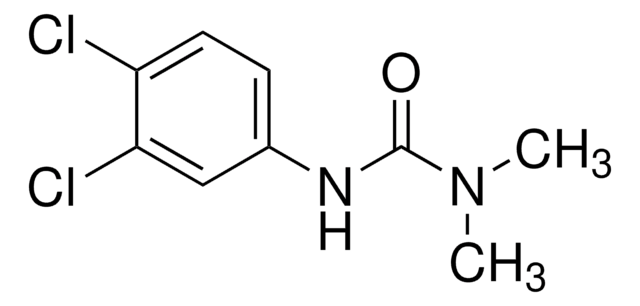Wichtige Dokumente
H9773
Hygromycin B aus Streptomyces hygroscopicus
lyophilized powder, suitable for plant cell culture, BioReagent
Synonym(e):
Hygromycin
Größe auswählen
Größe auswählen
About This Item
Empfohlene Produkte
Produktbezeichnung
Hygromycin B aus Streptomyces hygroscopicus, suitable for plant cell culture, BioReagent, ≥60% (HPLC), lyophilized powder
Biologische Quelle
Streptomyces hygroscopicus
Qualitätsniveau
Produktlinie
BioReagent
Form
lyophilized powder
Aufgereinigt durch
ion-exchange chromatography
Konzentration
≥60% (HPLC)
Methode(n)
cell culture | plant: suitable
Farbe
faintly brown to brown
white to beige
(1) 7.1, (2) 8.8
Löslichkeit
H2O: soluble 50 mg/mL
ethanol: soluble
methanol: soluble
Wirkungsspektrum von Antibiotika
fungi
Anwendung(en)
agriculture
Wirkungsweise
protein synthesis | interferes
Lagertemp.
2-8°C
SMILES String
CN[C@H]1C[C@@H](N)[C@H](O)[C@@H](O[C@@H]2O[C@H](CO)[C@H](O)[C@@H]3O[C@]4(O[C@H]([C@H](N)CO)[C@H](O)[C@H](O)[C@H]4O)O[C@H]23)[C@@H]1O
InChI
1S/C20H37N3O13/c1-23-7-2-5(21)9(26)15(10(7)27)33-19-17-16(11(28)8(4-25)32-19)35-20(36-17)18(31)13(30)12(29)14(34-20)6(22)3-24/h5-19,23-31H,2-4,21-22H2,1H3/t5-,6-,7+,8-,9+,10-,11+,12-,13+,14-,15-,16+,17+,18-,19+,20+/m1/s1
InChIKey
GRRNUXAQVGOGFE-XKIAHZFYSA-N
Suchen Sie nach ähnlichen Produkten? Aufrufen Leitfaden zum Produktvergleich
Allgemeine Beschreibung
Anwendung
Hygromycin B from Streptomyces hygroscopicus is used for gene cloning and ectopic expression.[2] It is also used in MS medium for the in vitro screening of transgenic plants.[3]
Biochem./physiol. Wirkung
Antimikrobielles Spektrum: Hygromycin B wirkt gegen Bakterien, Pilze und höhere eukaryotische Zellen.
Vorsicht
Angaben zur Herstellung
Signalwort
Danger
H-Sätze
Gefahreneinstufungen
Acute Tox. 1 Inhalation - Acute Tox. 2 Dermal - Acute Tox. 2 Oral
Lagerklassenschlüssel
6.1A - Combustible acute toxic Cat. 1 and 2 / very toxic hazardous materials
WGK
WGK 3
Flammpunkt (°F)
Not applicable
Flammpunkt (°C)
Not applicable
Hier finden Sie alle aktuellen Versionen:
Analysenzertifikate (COA)
Die passende Version wird nicht angezeigt?
Wenn Sie eine bestimmte Version benötigen, können Sie anhand der Lot- oder Chargennummer nach einem spezifischen Zertifikat suchen.
Besitzen Sie dieses Produkt bereits?
In der Dokumentenbibliothek finden Sie die Dokumentation zu den Produkten, die Sie kürzlich erworben haben.
Kunden haben sich ebenfalls angesehen
Artikel
Prevent fungal, yeast, and mold contamination in cell cultures. Discover the best antifungal agent for your cultures with the extensive Sigma® antifungal collection.
Antibiotics targeting bacterial ribosomes disrupt protein synthesis, a key process in bacterial growth inhibition.
Die Abtötungskurve von Antibiotika ist ein Dosis-Wirkungs-Versuch, in dem Säugerzellen zunehmenden Mengen eines selektiven Antibiotikums ausgesetzt werden
Antibiotic kill curve is a dose response experiment in which mammalian cells are subjected to increasing amounts of selection antibiotic
Protokolle
Reference guide and preparation guide for antibiotic and antimycotic use in plant tissue culture.
Aktive Filter
Unser Team von Wissenschaftlern verfügt über Erfahrung in allen Forschungsbereichen einschließlich Life Science, Materialwissenschaften, chemischer Synthese, Chromatographie, Analytik und vielen mehr..
Setzen Sie sich mit dem technischen Dienst in Verbindung.











